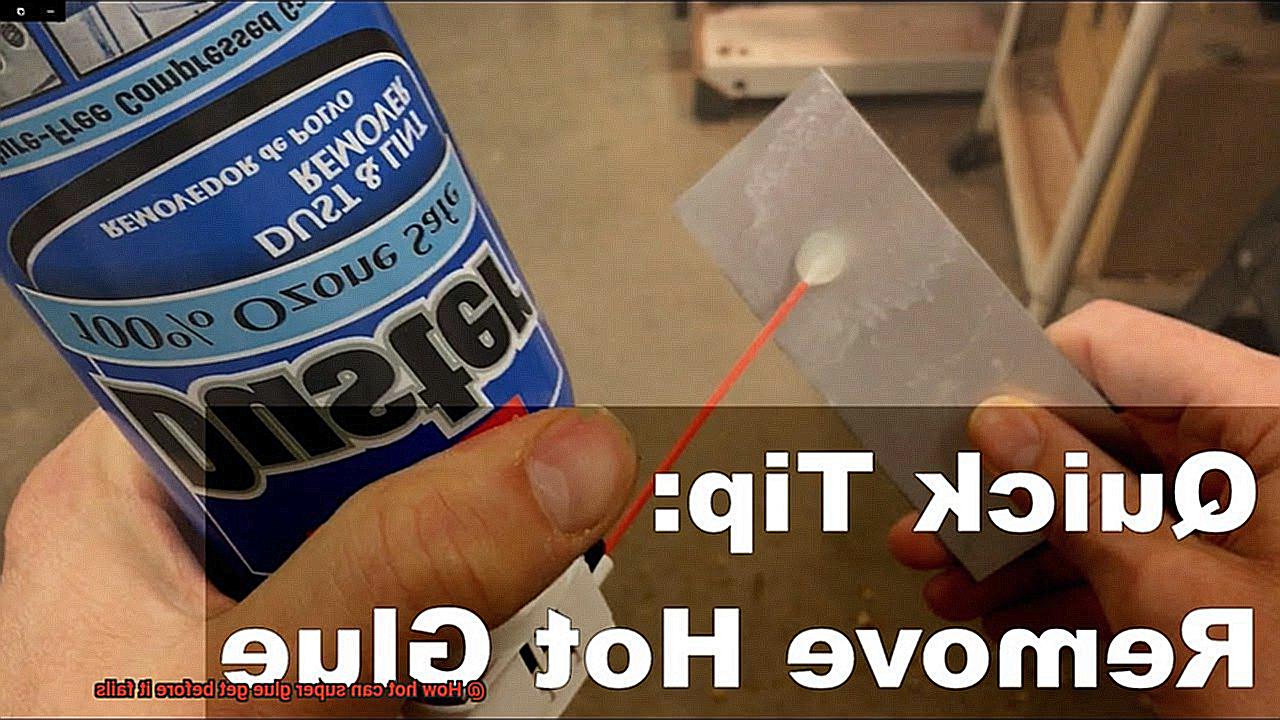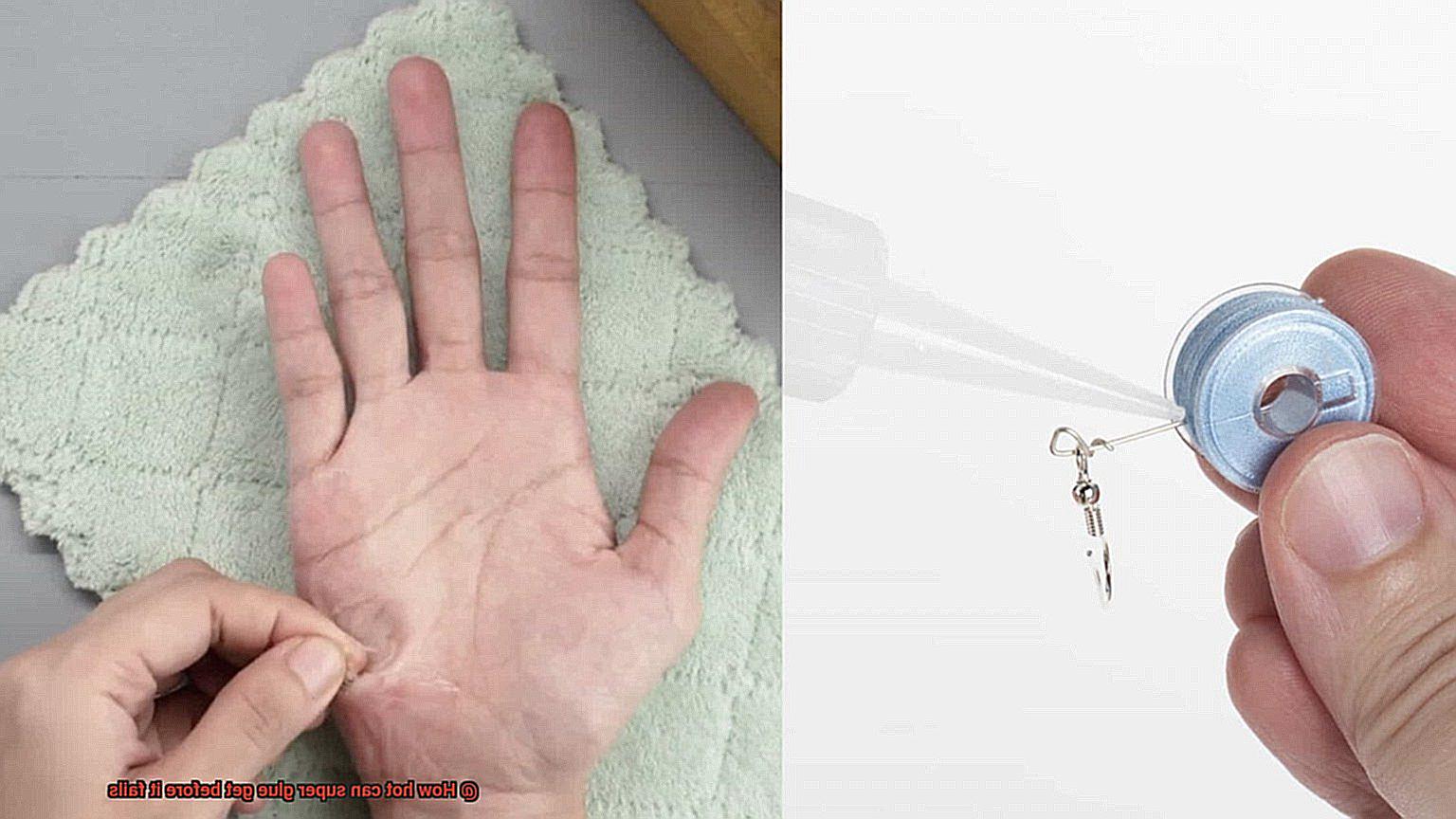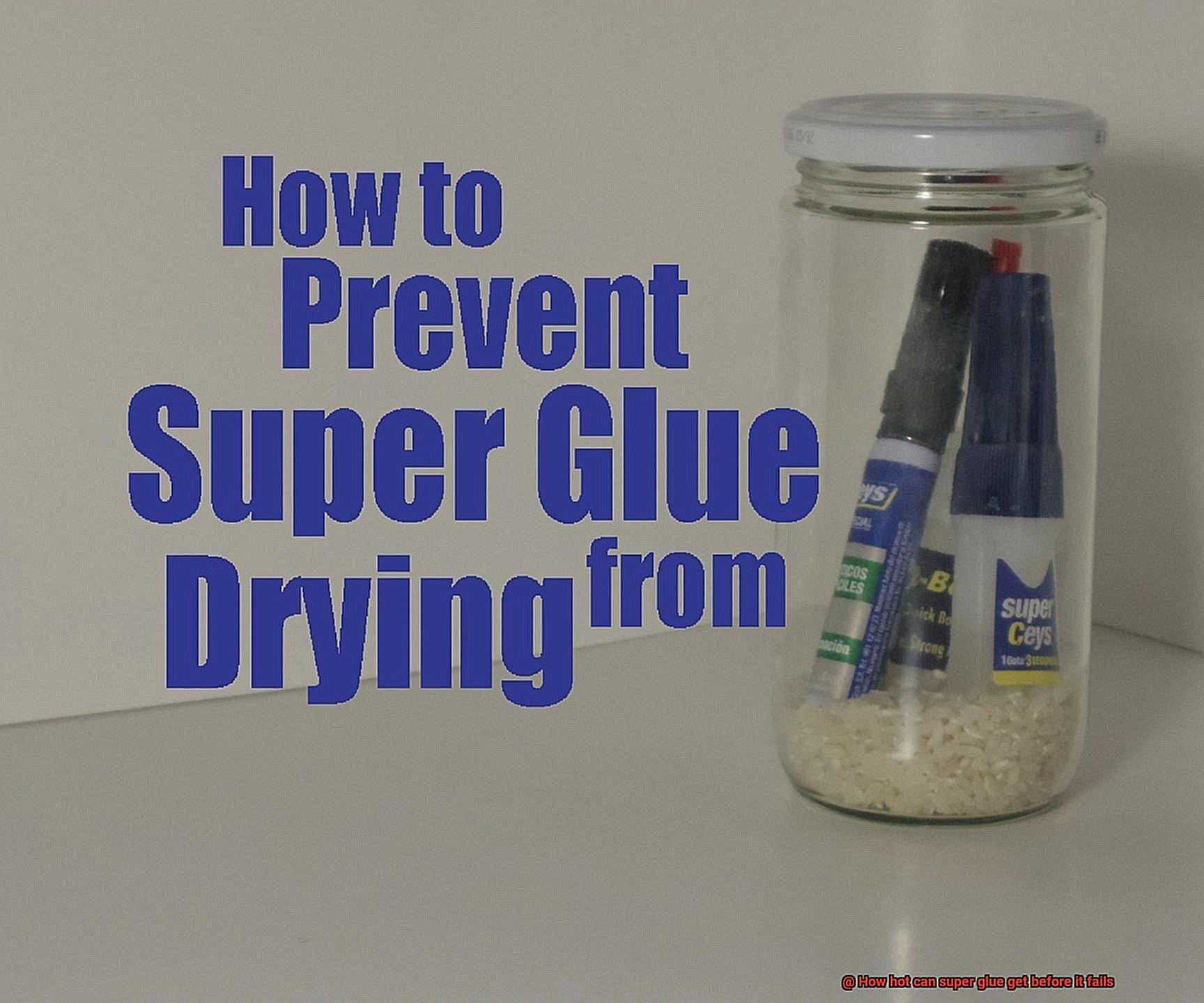Are you a DIY enthusiast or a hobbyist who relies on super glue to bond and fix items? If so, you might be wondering – how hot can super glue get before it fails? Well, the answer is not as simple as we’d like it to be. Super glue contains cyanoacrylate, a fast-drying adhesive that creates a robust bond between materials. While this adhesive is known for its strength and durability, it’s not invincible against heat.
As the temperature rises, the strength of the glue bond weakens and can eventually break down if exposed to extreme heat. But what exactly is the breaking point of super glue? How much heat can it endure before losing its bonding power? In this blog post, we’ll explore the science behind super glue and investigate the factors that influence its strength when subjected to high temperatures.
We’ll also examine real-world scenarios where super glue may fail due to excessive heat exposure. Additionally, we’ll discuss when it’s best to use heat-resistant adhesives instead of relying on super glue alone. So buckle up and join us on this exciting journey into the world of super glue.
What are the Benefits of Using Super Glue?
Contents
- 1 What are the Benefits of Using Super Glue?
- 2 How Hot Can Super Glue Get Before It Fails?
- 3 Factors That Affect the Temperature Tolerance of Super Glue
- 4 High-Temperature Super Glue: When You Need Extra Strength
- 5 Tips for Handling and Storing Super Glue
- 6 Potential Risks of Exposing Super Glue to High Temperatures
- 7 Alternatives to Using Super Glue in High-Temperature Environments
- 8 Conclusion
Also known as cyanoacrylate glue, this adhesive is a go-to choice for both professional and DIY applications due to its strength and versatility.
Quick Bonding Time

One of the most significant advantages of super glue is its quick bonding time. It can bond almost anything in seconds, making it perfect for those who need to complete their work quickly and efficiently. Whether you’re repairing broken objects or creating something new, super glue’s fast bonding time ensures that you can get your work done in no time.
Versatility
Super glue can bond a wide range of materials, including metal, plastic, wood, and ceramics. This versatility makes it an excellent choice for various applications such as automotive repairs or industrial manufacturing. Additionally, it can be used to fill gaps and even create jewelry.
Resistance to Water and Chemicals
Super glue is also resistant to water and most chemicals, making it ideal for applications that require durability and longevity. It won’t lose its bonding strength even when exposed to harsh environments over time. You can rely on super glue to provide a long-lasting hold that will not break down.
Ability to Withstand Extreme Temperatures
Another notable benefit of super glue is its ability to withstand extreme temperatures ranging from -65°F to 180°F. This makes it suitable for use in a wide range of environments, including outdoor applications. However, it’s essential to note that extreme heat can cause the glue to dry out and become brittle. Therefore, it is recommended to avoid exposing it to excessive heat or cold.
Ease of Use
Super glue is easy to use thanks to its applicator tip, which allows for precise application. Its clear and transparent drying feature makes it perfect for use on objects that require an invisible bond, such as glass or crystal. Moreover, once cured, super glue is non-toxic, making it safe for use in household applications.
How Hot Can Super Glue Get Before It Fails?
Super glue, or cyanoacrylate adhesive, is a remarkable bonding agent that has become a go-to for countless applications, from woodworking to medical procedures. This adhesive is hailed for its rapid-drying properties and ability to create an almost unbreakable bond. However, even the mighty super glue has its limitations when it comes to temperature resistance.

The temperature at which super glue will fail depends on a variety of factors, including the material the glue is adhered to and the temperature that material is exposed to. Generally speaking, super glue can endure temperatures up to 180°F (82°C) before it starts to lose its bonding strength. But keep in mind that this threshold can fluctuate based on humidity levels and exposure time.
It’s important to note that although super glue may hold up under high temperatures, it won’t maintain the same strength or durability as when it was initially applied under normal conditions. Once temperatures exceed 180°F (82°C), the adhesive may begin to break down and become brittle, ultimately losing its adhesive qualities. This can be dangerous in certain situations where separation of bonded materials could cause harm.
So what’s the bottom line? Super glue can endure temperatures up to 180°F (82°C) before it starts to fail. However, consumers should consider the threshold of the materials being bonded and refrain from exposing them to extreme heat if a robust bond is necessary. If working in hot environments or with materials that require a stronger bond, specialized high-temperature adhesives might be necessary.
Factors That Affect the Temperature Tolerance of Super Glue
Super glue is a household staple known for its quick-drying time and strong bonding capabilities. However, it’s essential to note that this miracle adhesive has temperature limitations. The temperature tolerance of super glue refers to the maximum and minimum temperatures that the glue can withstand before it fails. So, what factors affect the temperature tolerance of super glue? Let’s take a closer look.
Surface Type:
The type of surface being glued together is a critical factor affecting the temperature tolerance of super glue. Surfaces with high thermal conductivity, such as metals, can conduct heat away from the glue more efficiently than surfaces with low thermal conductivity, like plastics. As a result, if you’re gluing metal surfaces, your super glue will have a lower temperature tolerance compared to plastic surfaces.
Amount of Glue Used:
The amount of glue being used is another crucial factor to consider when it comes to the temperature tolerance of super glue. Applying too much glue can cause it to take longer to dry and affect its ability to withstand high temperatures. Therefore, it’s essential to apply just enough glue to create a strong bond without overloading the surface.
Environmental Conditions:
Environmental conditions play a vital role in determining the temperature tolerance of super glue. Extreme hot or cold temperatures can cause the glue to become brittle or lose its adhesion properties, leading to failure. Additionally, high humidity levels can affect the curing time of super glue, making it less effective.
Quality/Type of Glue Used:
The quality and type of super glue used can significantly impact its temperature tolerance. Industrial-grade super glues are designed to withstand higher temperatures than regular household glues. Therefore, choosing the right type of super glue for the job at hand is crucial to ensure maximum effectiveness and durability.
High-Temperature Super Glue: When You Need Extra Strength

High-temperature super glue is here to save the day and provide the extra strength and durability you need.
One of the key benefits of using high-temperature super glue is its ability to withstand extreme heat. This adhesive is specially designed for industrial applications where high temperatures are involved, making it ideal for producing automotive parts or electronic components. Unlike regular super glue, which loses its hold at temperatures above 150°F, high-temperature super glue can maintain its strength and integrity in much hotter environments.
However, the benefits of high-temperature super glue extend beyond industrial applications. It also provides extra strength and durability compared to other types of adhesives, making it perfect for construction projects or metalworking where a strong bond is essential. Additionally, this adhesive can be used to repair items exposed to high temperatures such as ovens, grills, or other appliances.
Using high-temperature super glue correctly is crucial for achieving the best results. Following the manufacturer’s instructions carefully is essential, which may include using a special applicator or mixing the adhesive with a catalyst to activate it. Allowing sufficient time for the adhesive to dry and cure before exposing it to high temperatures is also key.
Tips for Handling and Storing Super Glue
Super glue is a versatile adhesive that can bond quickly and securely. However, it is important to handle and store it properly to avoid any accidents. Here are five safety tips to consider when dealing with super glue.
Protect Your Skin and Eyes
When applying super glue, it’s important to protect your skin and eyes. Always wear gloves and safety glasses to prevent accidental contact with the glue. If you do get super glue on your skin, immediately rinse it off with warm water and soap.
Work in a Well-Ventilated Area
Super glue releases fumes that can cause irritation and respiratory problems. Therefore, it’s essential to work in a well-ventilated area to avoid inhaling the fumes from the glue.
Store in a Cool, Dry Place
Exposure to heat or moisture can cause the glue to break down and become less effective. Therefore, it’s essential to keep the glue in a cool, dry place away from direct sunlight or heat sources.
Keep the Cap Tightly Closed
After each use, make sure to keep the cap tightly closed to prevent air from entering the container and drying out the glue. Additionally, be sure to wipe off any excess glue from the nozzle before storing it to prevent clogging.
Keep Out of Reach of Children and Pets
Super glue is toxic if ingested, and accidental consumption can be fatal. Therefore, it’s crucial to store super glue out of reach of children and pets.
Potential Risks of Exposing Super Glue to High Temperatures
Super glue is a versatile adhesive that can be found in many toolboxes and craft kits. Its ability to bond surfaces quickly and effectively has made it a go-to solution for many projects. However, it’s crucial to understand the potential risks of exposing super glue to high temperatures.
One of the most significant risks of heat exposure is the breakdown of the adhesive bond. When subjected to high temperatures, super glue can become brittle and lose its bonding properties. This can cause objects to come apart, which is not only frustrating but also potentially dangerous.
But that’s not all – exposure to high temperatures can also lead to more severe consequences. Super glue contains chemicals like cyanoacrylate that are highly flammable. When exposed to heat, these chemicals can ignite and start a fire. To prevent this, it’s essential to store super glue in a cool, dry place away from any sources of heat or flames.
Another risk of heat exposure is the release of toxic fumes. Super glue fumes can be harmful if inhaled, causing irritation to the eyes, nose, and throat and even respiratory issues. It’s vital to use super glue in a well-ventilated area and avoid heating it up or using it near sources of heat.
To sum up, while super glue is a powerful adhesive, it’s essential to handle it with caution and avoid exposing it to high temperatures. Here are some tips to keep in mind:
- Store super glue in a cool, dry place away from any sources of heat or flames.
- Use super glue in a well-ventilated area.
- Avoid heating up super glue or using it near sources of heat.
- Always read and follow the manufacturer’s instructions.
Alternatives to Using Super Glue in High-Temperature Environments
As an expert on adhesives, I have extensively researched and compiled a list of alternative options that could be just what you need.
Firstly, high-temperature epoxy is a popular alternative to super glue. This two-part adhesive is widely used in the construction and automotive industries where high temperatures are common. It offers excellent resistance to heat, chemicals, and impact while providing a strong bond.
Another option is silicone adhesives, which are known for their flexibility and high-temperature resistance. These adhesives can withstand temperatures of up to 500°F and are frequently used in the aerospace and electronics industries.
Welding is also a viable alternative for high-temperature environments. By melting two metals together, welding creates a bond that is incredibly strong and able to withstand high temperatures. This technique is commonly used in the manufacturing and construction industries.
It’s essential to consider alternatives when working in high-temperature environments as super glue may not be suitable. High-temperature epoxy, silicone adhesives, and welding offer more reliable options that provide the strength and durability needed for these situations.
Conclusion
To sum it up, super glue is a versatile adhesive that has become a household name due to its quick-drying properties. However, when it comes to high temperatures, super glue can fail and lose its grip. The strength of the bond depends on various factors such as the surface being bonded, the amount of glue used, environmental conditions, and the quality/type of glue used.
It’s crucial to handle and store super glue with care to avoid any mishaps or risks associated with heat exposure. Furthermore, in high-temperature environments where super glue may not be suitable, it’s essential to consider alternatives such as high-temperature epoxy, silicone adhesives, or welding for more reliable options that offer greater strength and durability.
In conclusion, understanding the science behind super glue and its limitations is vital for DIY enthusiasts and hobbyists looking for successful results. By following safety guidelines and considering alternative options when necessary, individuals can make informed decisions while minimizing risks associated with heat exposure.






